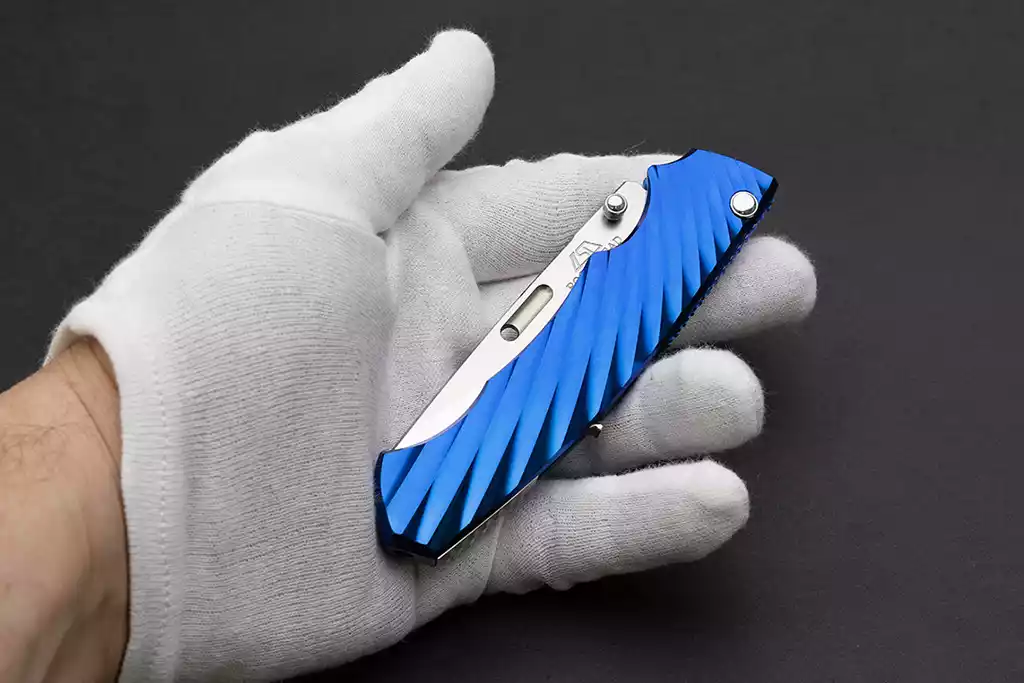
Rockstead knives are manufactured by the Japanese company Ishida Industrial Company Ltd. The company was founded in 1931 by President Ishida Yasukichi. The main activity of the company is the production of agricultural hand tools. In 1976, the company established a special department for the development and production of automatic equipment to automate complex mechanical processes in the processing of parts.
In the late 90s, the renowned Japanese gunsmith Kitano Katsumi contacted Ishida Industrial Company Ltd. He proposed to organize the serial production of knives of his design. By that time, Master Kitano had developed his unique, asymmetric blade profile called "Kitano Edge," which none of the existing knife companies had undertaken to reproduce on an industrial scale.
The second-generation president of Ishida Industrial Company Ltd., a great admirer of Kitano's work and a knife enthusiast, took up this difficult task.
The first knives under the Rockstead brand with a cutting edge "Kitano Edge" appeared on the market in 2000 and took top positions in the list of the most iconic knives in the world.
The name "Rockstead" comes from the English version of the Japanese word Ishida (from Ishida Industrial Company Ltd), which means Stone Field in Japanese.
The highest quality, practical design, incredible sharpness, and resistance of the blade immediately became the trademark of this brand. Later, Rockstead developed its models with a lenticular profile of the Honzukuri cutting edge.
All knives manufactured by Rockstead are categorized as "machine-custom," which means knives are half-automatic and half-hand. This is because automatic CNC machines allow you at the initial stage to create parts with an error of only a few microns (impossible accuracy for manual production), and manual sharpening and final polishing allows you to give blades of the most complex geometry a fantastic sharpness and to mirror that can be reproduced none automatic machine. It is important to note that the manual part of the work takes most of the entire production process, but it is the use of automated and manual labor that makes it possible to create knives not only of high quality but knives of the "formula-1" class in the knife world.
Rockstead produces about 1000 knives of all models per year. Moreover, the maximum possible circulation of each model is limited and does not exceed 250 pieces. All parts and their processing are carried out only in factories within Japan. At the moment, six craftsmen are working on the production of knives.
According to the manufacturer, Rockstead knives have three main distinguishing features:
1. The unique geometry of the Rockstead blade
Most Rockstead knives come in Honzukuri geometry. Many amateurs of Japanese martial arts know that "Honzukuri" or "complex symmetric lens" is one of the fundamental classical geometries of the blade of the Japanese sword Katana. Unlike the western counterparts of the "simple lenticular" blade, the Japanese "Honzukuri" has a smoother geometry and a variable angle throughout the sword's length. Due to this, the ease of cutting of "Honzukuri" is not inferior to blades with straight slopes "Plain," which have a smaller sharpening angle RK. This effect is achieved since the resistance of a larger angle of sharpening of the cutting edge of "Honzukuri" is compensated by the highest level of polishing and the complete absence of micro saws on the RK.
Largely thanks to the geometry of "Honzukuri," Japanese swords acquired the title of the sharpest and most indestructible blades in the world.
Continuing the tradition of ancient Japanese armorers and using their research findings, Rockstead adapted the long geometry of the Honzukuri sword to the knife.
2. Finishing
Due to the complex lenticular geometry and high hardness of steel, the blade's surface is processed manually on special devices called "Kopna." "Kopna" in its essence resembles an improved "water" whetstone, where calibrated sandpaper plays the role of an abrasive, and special machine oil is used instead of traditional water.
This decision was dictated by the fact that ordinary water stones, although they can handle the complex geometry of the blade, are incredibly inconvenient to use and cannot take steels with high hardness.
As a result of manual polishing and sharpening, the blade receives a uniform mirror shine and an incredibly smooth cutting edge without the slightest hint of a micro-saw.
It takes about 8 hours of work for the master to polish one blade.
3. Blade materials.
For the production of blades, Rockstead uses only the most modern knife steels. As a rule, these are high-speed cutters made by Hitachi metals - YXR7 and stainless steel with high carbon content from the same manufacturer, brand ZDP-189. For some limited edition models, the HAP-72 matrix quick cutter is used. DLC or TiAln coating is applied to all blades from the "quick cut" to prevent corrosion
To summarize all of the above, it's safe to say that Rockstead Knives are some of the best knives in the world. Blade polishing and fitting of parts to the level of performance are significantly higher than any existing production knives that the Knife-Life team has ever seen in the entire history of our existence. We are delighted to be able to offer these unique knives to our customers. The Rockstead knife is certainly not cheap, but we are sure you are getting a worthwhile thing by purchasing a knife under this brand.
A limited lifetime warranty backs all Rockstead knives.







Comments